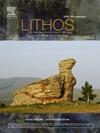Petrogenesis and emplacement of the Paleoproterozoic A-type Marajoara granite in the Carajás province, southeastern Amazonian craton: Constraints from geochemistry, zircon geochronology, NdHf isotopes, coexistence of reduced and oxidized magmas and new insights from a composite dike
IF 2.5
2区 地球科学
Q2 GEOCHEMISTRY & GEOPHYSICS
引用次数: 0
Abstract
The Marajoara granite is a Paleoproterozoic A-type stock that intruded into Mesoarchean tonalitic granitoids in the Rio Maria domain. It is composed of two compositionally and texturally distinct facies: equigranular (eBMzG) and heterogranular (hBMzG) biotite monzogranites. A rapakivi texture and the occurrence of microgranular enclaves (ME) and porphyritic ME (pME) are restricted to the hBMzG facies. The magnetic susceptibility values and the presence of magnetite indicate that the hBMzG facies is akin to granites from the magnetite series, whereas the eBMzG variety shows affinity with the granites of ilmenite series. These granites are high-silica, peraluminous and similar to ferroan granites. The hBMzG and pME show affinities with oxidized and the eBMzG with reduced A-type granites in the Jamon and Velho Guilherme suites, respectively. The ME have affinities with magnesian granites and the calc-alkaline series. U![]() Pb zircon analyses (SHRIMP) yield a crystallization age of 1884 ± 11 Ma for the hBMzG. Lu
Pb zircon analyses (SHRIMP) yield a crystallization age of 1884 ± 11 Ma for the hBMzG. Lu![]() Hf and Sm
Hf and Sm![]() Nd isotope data ƐHf(1.88 Ga) values range from −11 to −18 (hBMzG), while ƐNd(1.88 Ga) values vary from −9 to −11. The Hf-TDMC model ages are between 3.2 and 3.6 Ga, whereas the Nd-TDMC ages range from 2.9 to 3.6 Ga, indicating that the Marajoara granite-forming magma originated from a Meso- to Paleoarchean crustal source. Whole-rock geochemical data reveal compositional gaps, in terms of major and trace elements, between the two varieties that constitute the Marajoara granite, supporting the interpretation that they are not cogenetic. Geochemical modeling indicates that the original magmas were generated from partial melting of tonalitic rocks, with assimilation of metasedimentary rocks in the case of eBMzG. The contrasting redox states and modeling outcomes support distinct petrogenetic paths for the two facies. Felsic–mafic magma mixing played an important role in the crystallization history of the granite. The enclaves represent a basic magma from the lithospheric mantle that was injected into the magma chamber during underplating, where it interacted with the Marajoara pluton. This hypothesis is reinforced by the occurrence of a 1.88 Ga porphyritic granite–diabase composite dike in the Rio Maria area, provides independent evidence of bimodal magmatism. Microgranular and porphyritic enclaves formed due to the mixing of the felsic and mafic magmas. The results presented in this work highlight the importance of the Archean crust for the origin of Paleoproterozoic granites, whose emplacement at shallow crustal levels occurred through a dike feeder system resulting from extensional tectonics.
Nd isotope data ƐHf(1.88 Ga) values range from −11 to −18 (hBMzG), while ƐNd(1.88 Ga) values vary from −9 to −11. The Hf-TDMC model ages are between 3.2 and 3.6 Ga, whereas the Nd-TDMC ages range from 2.9 to 3.6 Ga, indicating that the Marajoara granite-forming magma originated from a Meso- to Paleoarchean crustal source. Whole-rock geochemical data reveal compositional gaps, in terms of major and trace elements, between the two varieties that constitute the Marajoara granite, supporting the interpretation that they are not cogenetic. Geochemical modeling indicates that the original magmas were generated from partial melting of tonalitic rocks, with assimilation of metasedimentary rocks in the case of eBMzG. The contrasting redox states and modeling outcomes support distinct petrogenetic paths for the two facies. Felsic–mafic magma mixing played an important role in the crystallization history of the granite. The enclaves represent a basic magma from the lithospheric mantle that was injected into the magma chamber during underplating, where it interacted with the Marajoara pluton. This hypothesis is reinforced by the occurrence of a 1.88 Ga porphyritic granite–diabase composite dike in the Rio Maria area, provides independent evidence of bimodal magmatism. Microgranular and porphyritic enclaves formed due to the mixing of the felsic and mafic magmas. The results presented in this work highlight the importance of the Archean crust for the origin of Paleoproterozoic granites, whose emplacement at shallow crustal levels occurred through a dike feeder system resulting from extensional tectonics.
亚马逊河克拉通东南部Carajás省古元古代a型Marajoara花岗岩的岩石成因和侵位:地球化学、锆石年代学、NdHf同位素、还原和氧化岩浆共存的约束以及复合岩脉的新认识
Marajoara花岗岩是侵入里约热内卢Maria域中中太古宙调性花岗岩的古元古代a型花岗岩。它由两种成分和质地截然不同的相组成:等粒(eBMzG)和异粒(hBMzG)黑云母二长花岗岩。微颗粒包体(ME)和斑状ME (pME)的出现仅限于hBMzG相。磁化率值和磁铁矿的存在表明hBMzG相与磁铁矿系列中的花岗岩相似,而eBMzG相则与钛铁矿系列中的花岗岩有亲缘关系。这些花岗岩是高硅质、过铝质,类似于铁质花岗岩。在Jamon套和Velho Guilherme套中,hBMzG和pME分别与氧化a型花岗岩亲和,eBMzG与还原a型花岗岩亲和。ME与镁质花岗岩和钙碱性花岗岩具有亲缘关系。UPb锆石分析(SHRIMP)得出hBMzG的结晶年龄为1884±11 Ma。LuHf和SmNd同位素数据ƐHf(1.88 Ga)的取值范围为−11 ~−18 (hBMzG), ƐNd(1.88 Ga)的取值范围为−9 ~−11。Hf-TDMC模式年龄在3.2 ~ 3.6 Ga之间,Nd-TDMC模式年龄在2.9 ~ 3.6 Ga之间,表明Marajoara花岗岩岩浆起源于中-古太古代地壳。全岩地球化学数据显示,在主要元素和微量元素方面,构成马拉约拉花岗岩的两个品种之间存在成分差距,支持它们不是同成因的解释。地球化学模拟表明,原始岩浆是由调性岩的部分熔融作用产生的,在eBMzG中有变质沉积岩的同化作用。对比的氧化还原状态和模拟结果支持了两种相不同的岩石成因路径。长镁质岩浆混合在花岗岩结晶史中起着重要作用。这些飞地代表了岩石圈地幔中的基性岩浆,这些岩浆在底板期间被注入岩浆房,并在那里与马拉约拉岩体相互作用。在里约热内卢Maria地区发现的1.88 Ga斑岩花岗岩-辉绿岩复合岩脉强化了这一假设,为双峰岩浆作用提供了独立证据。由于长英质岩浆和镁质岩浆的混合作用,形成了微颗粒和斑岩包体。本文的研究结果强调了太古宙地壳对古元古代花岗岩起源的重要性,这些花岗岩的侵位发生在地壳浅层,是由伸展构造形成的脉流系统造成的。
本文章由计算机程序翻译,如有差异,请以英文原文为准。
求助全文
约1分钟内获得全文
求助全文
来源期刊

Lithos
地学-地球化学与地球物理
CiteScore
6.80
自引率
11.40%
发文量
286
审稿时长
3.5 months
期刊介绍:
Lithos publishes original research papers on the petrology, geochemistry and petrogenesis of igneous and metamorphic rocks. Papers on mineralogy/mineral physics related to petrology and petrogenetic problems are also welcomed.
 求助内容:
求助内容: 应助结果提醒方式:
应助结果提醒方式:


